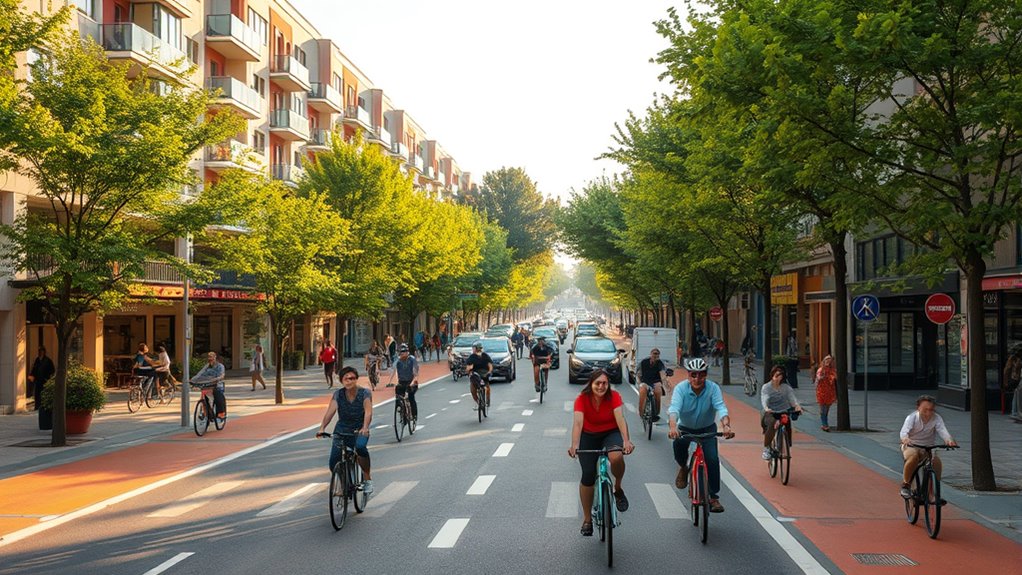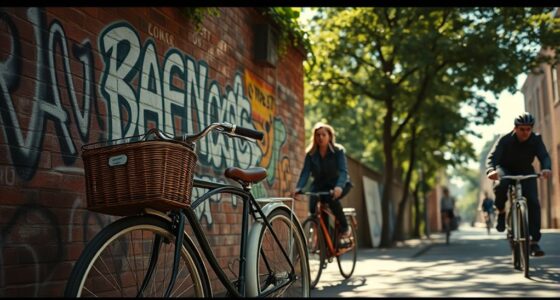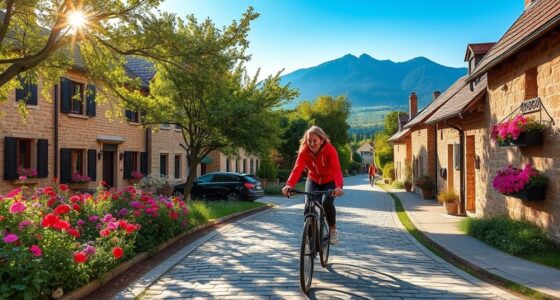If you’re looking for cycle-friendly cities that won’t break the bank, consider Copenhagen or Groningen, where affordable living meets extensive bike lanes and vibrant cycling communities. Portland and Vilnius also offer budget-conscious options with good infrastructure and active initiatives. Cities like Budapest, Valencia, and Leipzig combine low costs with great cycling amenities, making them ideal for sustainable urban living. Keep exploring—more examples and insights await to help you find the perfect affordable cycling city.
Key Takeaways
- Cities like Copenhagen, Groningen, and Ljubljana offer extensive, affordable cycling infrastructure that reduces transportation costs and promotes bike use.
- Compact urban designs with mixed-use development lower travel distances and infrastructure expenses, making cycling more affordable.
- Budget-friendly cities implement bike-sharing programs and community events that encourage cycling without high ownership costs.
- Green urban planning and bike-friendly policies enhance safety, accessibility, and environmental benefits at affordable living costs.
- Well-planned cycling networks in cities such as Portland and Valencia improve mobility, safety, and affordability for residents.
Copenhagen, Denmark: The Model City for Affordable Cycling
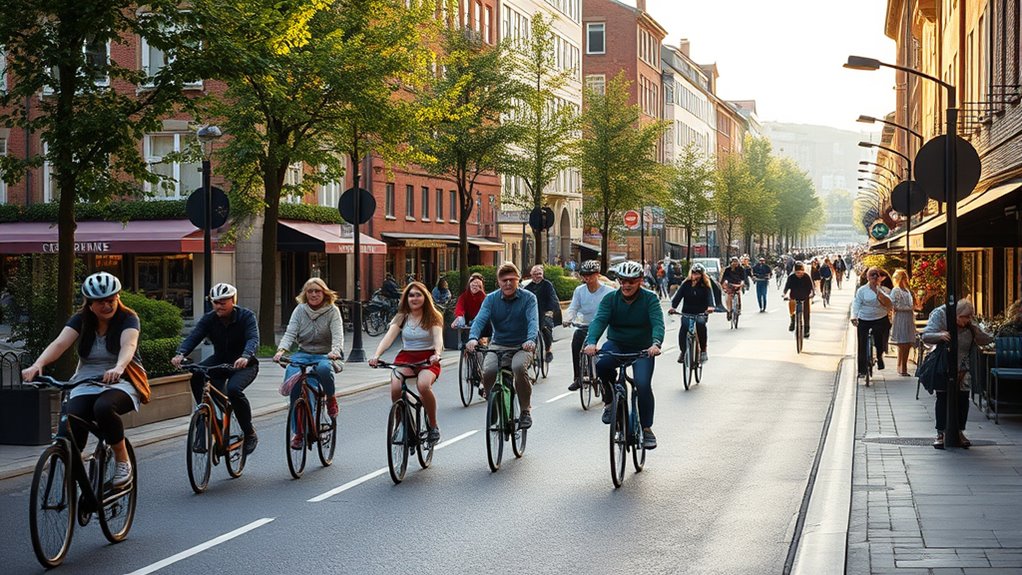
Copenhagen stands out as a premier example of a cycle-friendly city that remains affordable for residents. Its success stems from strategic urban planning that prioritizes cycling infrastructure, making bikes a practical choice for daily commutes. Wide, well-maintained bike lanes seamlessly connect neighborhoods, workplaces, and leisure areas. Additionally, Copenhagen’s extensive bike sharing programs offer affordable, convenient options for residents and visitors alike, reducing reliance on cars. The city’s investments in cycling infrastructure keep costs manageable and encourage more people to choose biking over driving. Network connectivity plays a crucial role in creating an integrated cycling system that supports sustainable urban mobility. This combination of thoughtful urban planning and accessible bike sharing creates an environment where cycling is not only practical but also economical. As a result, Copenhagen sets a benchmark for cities aiming to promote affordable, sustainable transportation.
Groningen, Netherlands: Compact, Cost-Effective Cycling Paradise

In Groningen, you’ll find a compact city designed for easy cycling, making it simple to reach everything without hassle. The city invests in affordable cycling infrastructure that keeps costs low and encourages more bike use. Plus, Groningen’s student-friendly atmosphere makes cycling a natural, budget-friendly choice for many residents. The city’s focus on creating a cozy, inviting environment further enhances its reputation as a cycling paradise. Additionally, the widespread adoption of wall organization systems helps keep public spaces tidy and accessible for cyclists and pedestrians alike. Incorporating environmental considerations such as sustainable design and low-impact infrastructure further solidifies Groningen’s commitment to eco-friendly urban living. To ensure safe and efficient rides, many residents learn proper shifting techniques, making cycling both enjoyable and reliable for daily commutes. Furthermore, the city’s emphasis on natural techniques for sustainable seed production exemplifies its dedication to environmentally responsible practices across various sectors.
Compact City Design
Ever wondered how a compact city design can make cycling both affordable and practical? It all starts with smart urban planning that concentrates amenities, residences, and workplaces within close reach. This layout reduces travel distances, making cycling an easy choice for daily commutes. Effective traffic management ensures that bikes move smoothly, without unnecessary delays or safety concerns. Narrow streets, mixed-use development, and accessible public spaces foster a pedestrian-friendly environment, encouraging more people to choose cycling over cars. Groningen exemplifies this approach, where city planners prioritize density and connectivity. By designing cities that are compact and well-organized, you benefit from lower transportation costs and less reliance on expensive infrastructure. This creates a cycle-friendly environment that’s not only affordable but also enjoyable to live in.
Affordable Cycling Infrastructure
Groningen, Netherlands, exemplifies how affordable cycling infrastructure can transform urban living. The city’s effective urban planning prioritizes safe, accessible bike lanes that cost little to maintain and expand. Bike sharing programs further enhance affordability, allowing residents and visitors to access bikes without ownership costs. These initiatives reduce reliance on cars, lowering transportation expenses and traffic congestion. The city’s compact layout makes cycling a practical, quick alternative to driving, making it easy to reach shops, workplaces, and parks. With affordable infrastructure and strategic urban planning, Groningen demonstrates that creating a bike-friendly city doesn’t have to break the bank. Instead, it offers a sustainable, cost-effective way to improve mobility, health, and quality of life for all residents. Additionally, Gold IRA options are available for those interested in diversifying their retirement portfolios with precious metals, providing a stable hedge against inflation and economic uncertainties. Implementing protective styling benefits like crochet locs can also help preserve the integrity of urban hair textures amidst active lifestyles. Furthermore, investing in diverse plant options can enhance urban greenery and improve air quality, contributing to a healthier city environment. Incorporating innovative urban designs can maximize space efficiency and provide additional cost savings.
Student-Friendly Environment
Thanks to its compact layout and affordable cycling infrastructure, Groningen is a student’s paradise. You’ll find cycling safety prioritized with well-marked lanes and traffic-calming features that make riding feel secure. The city’s extensive network of bike paths allows you to navigate campus and city life effortlessly. Plus, bike sharing programs offer an affordable, convenient way to get around without owning a bike. These programs are perfect for students who need flexibility or want to avoid storage issues. With affordable cycling options and a focus on safety, Groningen encourages students to rely on bikes as their primary mode of transportation. This environment fosters independence, saves money, and keeps the city lively and accessible for everyone. Incorporating cycling-friendly features enhances the overall quality of urban living and supports sustainable transportation options.
Portland, Oregon: Balancing Budget and Bike Infrastructure
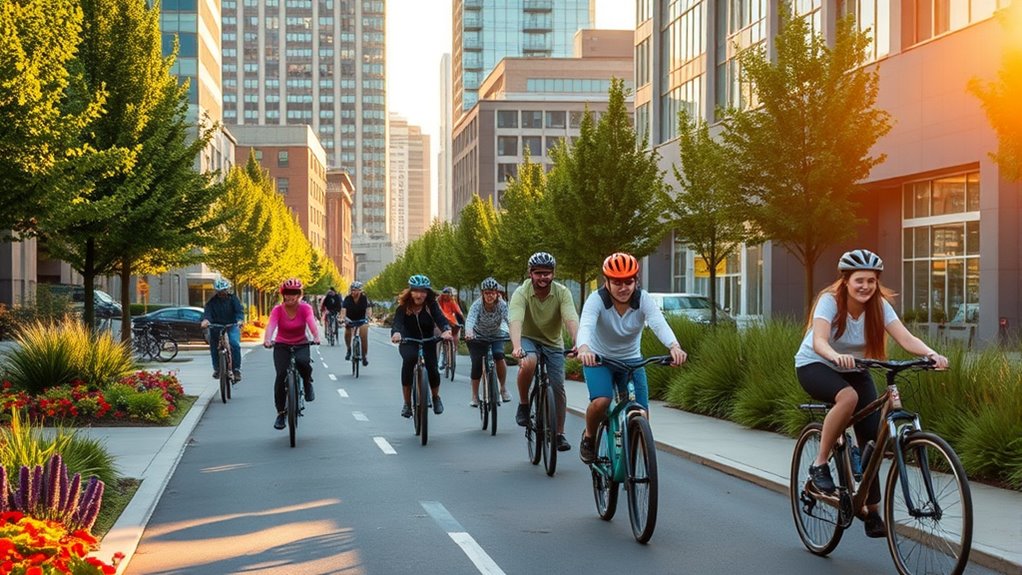
While Portland has made significant investments in its bike infrastructure, balancing those improvements with a manageable budget remains a challenge. Urban planning plays a key role as city officials prioritize expanding cycling lanes without overspending. Traffic management strategies help guarantee safety and efficiency, reducing congestion and encouraging more residents to bike instead of drive. However, funding constraints mean Portland must carefully allocate resources, often blending public funds with community-led initiatives. The city’s approach emphasizes cost-effective design and phased projects, aiming to maximize impact without breaking the bank. Incorporating cost-effective design strategies ensures that improvements remain within budget while serving the community’s needs. Additionally, leveraging urban planning principles can further optimize infrastructure investments and enhance overall city livability. Implementing budgeting strategies alongside community input helps sustain development efforts and adapt to changing needs. Effective traffic management is essential to balance growth and accessibility for all residents. By focusing on strategic urban planning and smart traffic management, Portland endeavors to maintain its reputation as a cycle-friendly city that remains accessible to residents of diverse budgets. Furthermore, applying efficient resource allocation practices can help ensure ongoing project sustainability and community support.
Vilnius, Lithuania: An Emerging Budget-Friendly Cycling Hub
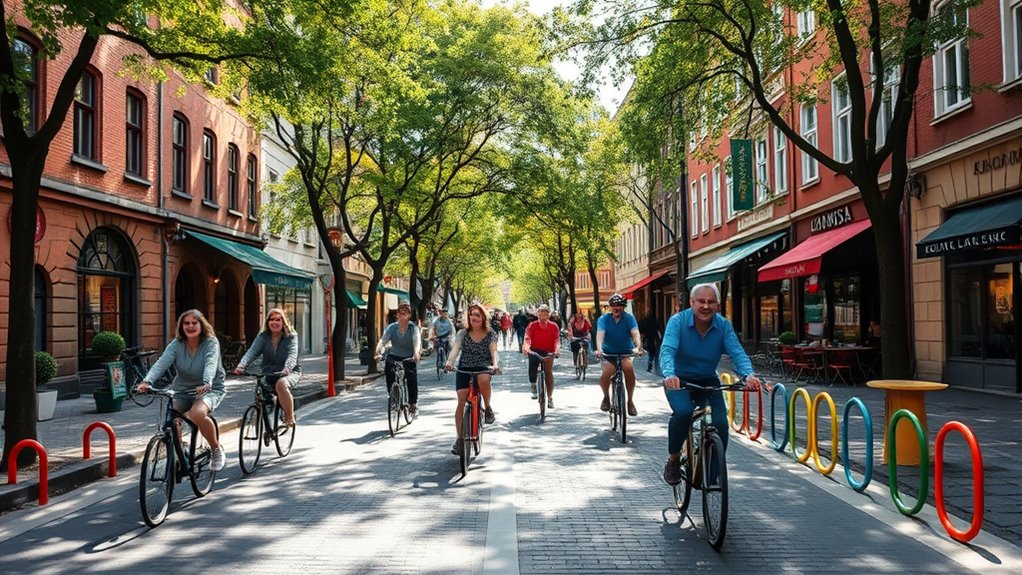
Vilnius is quickly expanding its cycling infrastructure, making it easier and safer to bike around the city. With lower living costs compared to other European capitals, you can enjoy a budget-friendly lifestyle while cycling daily. This combination makes Vilnius an emerging spot for affordable, bike-friendly living.
Cycling Infrastructure Expansion
As Vilnius ramps up its efforts to promote cycling, the city has invested in expanding its cycling infrastructure in a way that’s both effective and budget-friendly. This includes adding new bike lanes that prioritize bike lane safety, making your rides safer and more enjoyable. The city also plans cycling event planning to encourage community engagement and showcase cycling’s benefits. Here are four ways this expansion impacts you:
- Safer routes that reduce accidents and boost confidence.
- Increased accessibility, making cycling a practical daily choice.
- Enhanced bike lane safety encourages more people to ride.
- Community events foster a sense of belonging and shared purpose.
- The focus on affordable urban planning ensures that these improvements remain accessible to all residents.
Furthermore, incorporating cost-effective design strategies helps ensure that these infrastructure upgrades are sustainable and achievable within city budgets. Additionally, emphasizing environmentally friendly transportation aligns with global efforts to reduce urban pollution and carbon emissions. These initiatives also support the public health benefits associated with increased cycling activity.
This strategic infrastructure growth makes Vilnius more inviting for cyclists and demonstrates its commitment to sustainable city living.
Affordable Living Costs
Thanks to its affordable living costs, Vilnius has become an attractive destination for cyclists seeking a budget-friendly lifestyle. You can enjoy cycling without breaking the bank, thanks to affordable rent, food, and transportation options. The city offers bike sharing programs that make commuting easy and inexpensive, reducing your reliance on cars. Cycling safety campaigns are actively promoted, ensuring a secure environment for riders of all levels. These initiatives not only improve safety but also encourage more residents to choose cycling as their primary mode of transport. Additionally, the city’s cycling infrastructure is continually expanding to support eco-friendly transportation. As part of its commitment to cycling safety, Vilnius invests in educational programs and community events that foster a bike-friendly culture. Check out the table below to see how Vilnius compares in key cost areas: Vetted Bike Conversion Kits are widely available to enhance your cycling experience.
Budapest, Hungary: Affordable Urban Cycling in Central Europe
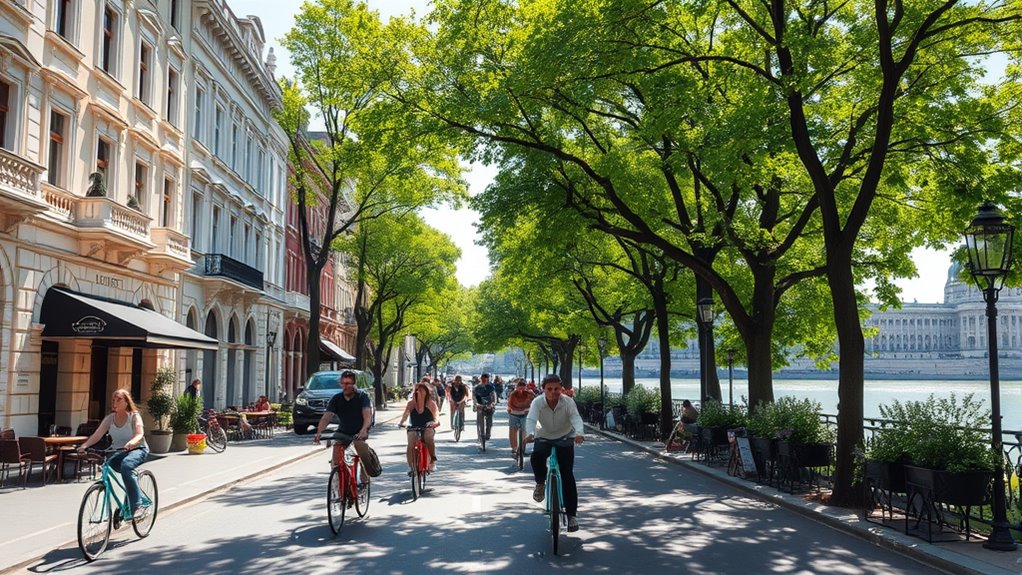
Budapest stands out as an affordable city in Central Europe where urban cycling is both practical and enjoyable. Thanks to thoughtful urban planning, the city has created smooth, dedicated bike lanes that make riding safe and accessible. You’ll love the convenience of extensive bike sharing programs, making it easy to explore without owning a bike. Cycling in Budapest isn’t just affordable; it’s freeing and fun.
Consider these highlights:
- Well-developed bike lanes that connect key neighborhoods
- Affordable bike-sharing schemes for residents and visitors
- City initiatives promoting sustainable transportation
- Scenic routes along the Danube and historic sites
With these features, Budapest offers a perfect blend of affordability, accessibility, and vibrant urban cycling culture.
Valencia, Spain: Sun-Kissed and Wallet-Friendly Cycling Options

Valencia, Spain, offers a sun-soaked and budget-friendly environment for urban cyclists seeking an affordable way to explore the city. Its well-designed urban planning emphasizes bike safety, with dedicated bike lanes that make commuting safe and smooth. Cycling here is accessible and enjoyable, thanks to the city’s flat terrain and mild climate. To highlight this, check out the table below:
| Feature | Benefit |
|---|---|
| Extensive bike lanes | Safe, stress-free rides |
| Low-cost bike rentals | Wallet-friendly commuting |
| Clear signage | Easy navigation |
| Community events | Promotes cycling culture |
With these features, Valencia encourages more residents to choose cycling, making it a truly cycle-friendly city you can afford to live in.
Leipzig, Germany: a City With a Growing Cycling Community
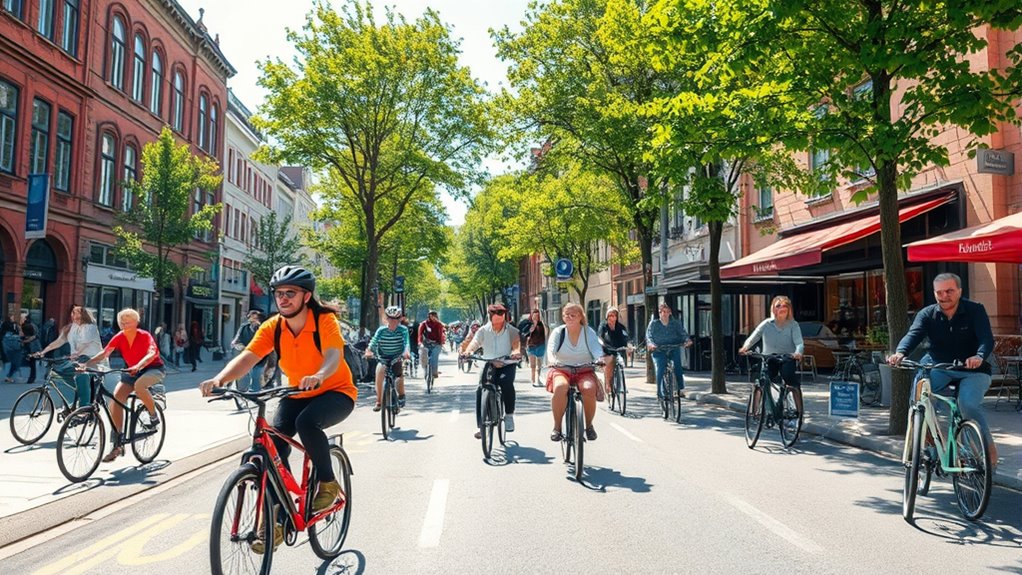
Leipzig, Germany, is rapidly transforming into a hub for cyclists, with more residents choosing bikes over cars each year. The city’s urban planning emphasizes bike-friendly infrastructure, making cycling safer and more accessible. Community engagement plays a crucial role, as local initiatives encourage residents to embrace active transportation. You’ll notice:
- Wide, well-maintained bike lanes that connect neighborhoods seamlessly
- Community-led events promoting cycling as a sustainable choice
- Smart urban design that prioritizes pedestrians and cyclists alike
- Local programs supporting affordable bike rentals and repairs
This combination of thoughtful planning and active community involvement fosters a vibrant cycling culture. Leipzig’s approach proves that building a cycle-friendly city is both achievable and affordable, inviting you to join the movement.
Pittsburgh, Pennsylvania: Revitalizing With Cost-Effective Cycling Initiatives

Pittsburgh is transforming its transportation landscape by implementing cost-effective cycling initiatives that prioritize community involvement and affordability. The city’s urban renewal efforts focus on expanding bike lanes and safe routes, making cycling accessible to all residents. These initiatives promote social equity by ensuring underserved neighborhoods gain better access to transportation options, reducing reliance on cars, and lowering costs. By involving local communities in planning, Pittsburgh fosters a sense of ownership and inclusivity. These measures not only improve mobility but also spark economic revitalization in neglected areas, making cycling a practical, affordable choice for everyday travel. Through strategic investments that emphasize social equity, Pittsburgh’s cycling infrastructure becomes a catalyst for sustainable growth and a more connected, equitable city.
Ljubljana, Slovenia: A Green and Budget-Conscious Bike City

Ljubljana, Slovenia, stands out as a model for green, budget-friendly urban cycling. Its abundant urban greenery creates a invigorating backdrop for daily rides, making cycling both enjoyable and healthy. Thanks to bike-friendly policies, the city has invested in extensive bike lanes and secure parking, fostering a safe environment for cyclists.
Ljubljana’s lush greenery and bike-friendly policies make urban cycling enjoyable, safe, and eco-conscious.
You’ll feel inspired by:
- The seamless network of bike paths connecting parks, historic sites, and neighborhoods
- Affordable bike rentals that let you explore without breaking the bank
- Local efforts to prioritize urban greenery, reducing pollution and enhancing quality of life
- Community events promoting cycling as a sustainable, budget-conscious lifestyle
Ljubljana proves that a city can be both eco-friendly and wallet-wise while embracing its cycling culture.
Frequently Asked Questions
What Are the Peak Costs Associated With Cycling in These Cities?
Peak costs when cycling include bike theft and weather challenges. You might spend more on secure bike locks or insurance to protect your ride from theft. Harsh weather, like rain or snow, can lead to wear and tear, increasing maintenance costs. These factors can raise your overall expenses, but staying vigilant and choosing weather-appropriate gear can help you manage costs effectively while enjoying city cycling.
How Do Bike-Sharing Programs Impact Affordability in These Locations?
Bike-sharing programs improve affordability by reducing your transportation costs. They make urban infrastructure more accessible without the need for personal bike ownership, saving you money. Subsidies for bike sharing lower the prices even further, encouraging more riders. This combination helps you enjoy cycling benefits in city environments without high peak costs, making it easier to stay within your budget while supporting eco-friendly transportation options.
Are There Specific Government Incentives for Budget-Friendly Cyclists?
Imagine you’re riding through a city that’s friendly to your budget. You’ll find government grants and tax incentives designed for cyclists, making it easier to afford a bike or upgrade your gear. Some cities offer subsidies or discounts on bike repairs and accessories. These incentives help you save money while embracing cycling as a sustainable and affordable transportation option, making city living both fun and budget-friendly.
How Accessible Are Cycling Repairs and Maintenance Services in These Cities?
You’ll find that cycling repairs and maintenance services are quite accessible in these cities, thanks to high bike shop density. The availability of multiple shops means you won’t struggle to find quick, convenient service. Maintenance affordability is also a priority, so prices tend to be reasonable, making it easier for you to keep your bike in top shape without breaking the bank. This combination guarantees your cycling experience remains smooth and budget-friendly.
What Safety Measures Are in Place for Budget-Conscious Urban Cyclists?
Did you know that cities with clear safety measures see a 25% reduction in cycling accidents? As a budget-conscious rider, you benefit from helmet laws that promote safety and well-maintained bike lane signage that guides you safely through urban streets. These measures make cycling safer and more accessible, ensuring you can enjoy your commute without worry. Staying aware and following these protections keeps your rides secure and affordable.
Conclusion
Now that you’ve seen these budget-friendly cycling cities, it’s clear you don’t have to break the bank to enjoy a bike-friendly lifestyle. Each city shows you can have your cake and eat it too—great infrastructure without draining your wallet. So, why not hop on your bike and explore these places? You might find that the grass is greener—and more affordable—on the cycling side. Time to pedal your way to a better, budget-conscious adventure!
